From Ireland to England, from Greece to the US of A.
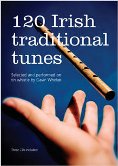 Gavin Whelan
got hooked on the tin whistle when hearing Micho Russell [#40].
He also incorporated the Co. Clare fiddle style in his playing,
and the tonguing technique of Mary Bergin.
To date Gavin has released three CDs [#41].
His "120 Irish Traditional Tunes" kicks off with a
short but concise introduction for beginners, including
style and technique, basic scales and ornamentation.
Then you're thrown into the cold water,
mind you, this is no tutorial but a collection -
especially for tunes that sit well on the D tin whistle.
42 jigs, 37 reels, 17 hornpipes, 8 slow airs, polkas and more as an encore.
There is trad from the "Abbey Reel" to the "Wren Polka",
but also Scott Skinner's "Hector the Hero" [#27],
Junior Creehan's "Mist Covered Mountain" [#42]
and Michael McGoldrick's [#41]
"Jig for Grace", plus some notes on sources, composers, recordings
(the discography is not limited to the whistle)
and more useful information
(and I don't mention it because this website here is cited).
The tunes are featured on altogether 3 CD's, played slow and at normal speed,
the latter accompanied by Gavin Ralston on guitar.
Gavin Whelan
got hooked on the tin whistle when hearing Micho Russell [#40].
He also incorporated the Co. Clare fiddle style in his playing,
and the tonguing technique of Mary Bergin.
To date Gavin has released three CDs [#41].
His "120 Irish Traditional Tunes" kicks off with a
short but concise introduction for beginners, including
style and technique, basic scales and ornamentation.
Then you're thrown into the cold water,
mind you, this is no tutorial but a collection -
especially for tunes that sit well on the D tin whistle.
42 jigs, 37 reels, 17 hornpipes, 8 slow airs, polkas and more as an encore.
There is trad from the "Abbey Reel" to the "Wren Polka",
but also Scott Skinner's "Hector the Hero" [#27],
Junior Creehan's "Mist Covered Mountain" [#42]
and Michael McGoldrick's [#41]
"Jig for Grace", plus some notes on sources, composers, recordings
(the discography is not limited to the whistle)
and more useful information
(and I don't mention it because this website here is cited).
The tunes are featured on altogether 3 CD's, played slow and at normal speed,
the latter accompanied by Gavin Ralston on guitar.
Gavin Whelan, 120 Irish Traditional Tunes.
Tallaght Records,
2010, ISBN 978-0-9566165-0-0, pp66, €27,- (incl. 3 CDs).
 German Nadia Birkenstock was led to the Celtic harp by Scots duo
Sileas. Since then she is successfully touring with a program for voice and harp.
Nadia's tune collection vol. 1 contains pieces from her debut album
"Emerald Isles" [#22]
to "Strange New Land" [#38].
6 instrumentals, featuring 2 of her own, but also the old Irish air
"The Coulin" (see also #45),
Carolans "Farewell to Music" and the
slide "Merrily Kiss the Quaker's Wife". Among the 7 songs are besides 3 of her own
the Welsh "All Through the Night" and the English "The Water Is Wide" and "The Cuckoo".
Nadia's music is generally dreamy and romantic.
Advanced harpists should easily dig the arrangements;
beginners are helped out with additional chord symbols.
German Nadia Birkenstock was led to the Celtic harp by Scots duo
Sileas. Since then she is successfully touring with a program for voice and harp.
Nadia's tune collection vol. 1 contains pieces from her debut album
"Emerald Isles" [#22]
to "Strange New Land" [#38].
6 instrumentals, featuring 2 of her own, but also the old Irish air
"The Coulin" (see also #45),
Carolans "Farewell to Music" and the
slide "Merrily Kiss the Quaker's Wife". Among the 7 songs are besides 3 of her own
the Welsh "All Through the Night" and the English "The Water Is Wide" and "The Cuckoo".
Nadia's music is generally dreamy and romantic.
Advanced harpists should easily dig the arrangements;
beginners are helped out with additional chord symbols.
Nadia Birkenstock, Celtic Harp & Song Vol. 1.
2010, pp55, €25,- (www.nadiabirkenstock.com).
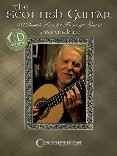 Scottish guitarist Rob MacKillop
(robmackillop.net,
rmguitar.info)
is an important performer of early music and has recorded several albums.
Here he specifies a uniquely Scottish way of guitar playing
and shows the stylistic differences between regions and periods
(though there is no strathspey or one of those A major fiddle tunes which I thought
so unmistakenly Scottish).
Rob is kicking off with tunes in the popular DADGAD tuning.
It commences with two preludes - improvised passages (toccatas) like the old lutenist used to do.
There's the popular airs "Roslin Castle" [#45]
and "Flooers o' the Forest", Neil Gow's "Farewell to Whisky"
and the lesser known "Welcome Whisky Back Again".
I once used to play the "Fisherman's Song for Attracting the Seals",
it hasn't travelled well, though it is such a great mesmerizing jig.
Section 2 introduces an open G tuning he got from rock guitarist Keith Richards (DGDGBD),
which is easier for keys from G to C#. It is very popular with blues slide guitarists,
and I know Steve Earle using it.
Eventually section 3 introduces tunes in open D tuning (DADF#AD)
and features Rob's transcriptions of 17th century Scottish lute music
- the roots of the roots of Scottish traditional music -
such as "The Canaries" (which Wendy Stewart and Gary West recorded
[#40]),
or "Port Rorie Dall" and "Port Atholl" (which I heard from harpist Simon Chadwick
[#36]).
The volume is finishing off with "For Old Long Syne,"
its earliest notated version and quite different to the melody used today
(though these tunes have been revived recently
[#45]).
Rob demonstrates his ideas with 40 pieces, including tablature and staff notes.
The tunes go from the easy to the difficult.
Ornaments are not written out, he shows the ones he's using, you can hear it on the CD,
as well as his phrasing akin to the phrasing of a traditional singer.
Regarding harmony, he avoids reducing the modal melodies to the major/minor system
and has minimal accompaniment or none at all.
Generally, "The Scottish Guitar" is more a collection than a tutorial,
for the latter turn to his previous book "Scottish Traditional Music for Guitar".
Scottish guitarist Rob MacKillop
(robmackillop.net,
rmguitar.info)
is an important performer of early music and has recorded several albums.
Here he specifies a uniquely Scottish way of guitar playing
and shows the stylistic differences between regions and periods
(though there is no strathspey or one of those A major fiddle tunes which I thought
so unmistakenly Scottish).
Rob is kicking off with tunes in the popular DADGAD tuning.
It commences with two preludes - improvised passages (toccatas) like the old lutenist used to do.
There's the popular airs "Roslin Castle" [#45]
and "Flooers o' the Forest", Neil Gow's "Farewell to Whisky"
and the lesser known "Welcome Whisky Back Again".
I once used to play the "Fisherman's Song for Attracting the Seals",
it hasn't travelled well, though it is such a great mesmerizing jig.
Section 2 introduces an open G tuning he got from rock guitarist Keith Richards (DGDGBD),
which is easier for keys from G to C#. It is very popular with blues slide guitarists,
and I know Steve Earle using it.
Eventually section 3 introduces tunes in open D tuning (DADF#AD)
and features Rob's transcriptions of 17th century Scottish lute music
- the roots of the roots of Scottish traditional music -
such as "The Canaries" (which Wendy Stewart and Gary West recorded
[#40]),
or "Port Rorie Dall" and "Port Atholl" (which I heard from harpist Simon Chadwick
[#36]).
The volume is finishing off with "For Old Long Syne,"
its earliest notated version and quite different to the melody used today
(though these tunes have been revived recently
[#45]).
Rob demonstrates his ideas with 40 pieces, including tablature and staff notes.
The tunes go from the easy to the difficult.
Ornaments are not written out, he shows the ones he's using, you can hear it on the CD,
as well as his phrasing akin to the phrasing of a traditional singer.
Regarding harmony, he avoids reducing the modal melodies to the major/minor system
and has minimal accompaniment or none at all.
Generally, "The Scottish Guitar" is more a collection than a tutorial,
for the latter turn to his previous book "Scottish Traditional Music for Guitar".
Rob MacKillop, The Scottish Guitar - 40 Scottish Tunes for Fingerstyle Guitar.
Centerstream,
2011, ISBN 978-1-57424-265-2, 65 S, US-$19.99 (incl. CD).
 Hawaiian guitar player Daniel Ho employs a simple method to play fingerstyle guitar.
The idea is using mostly open strings
(we're talking about standard tuning, not open tuning here).
The notion is: concerts can be long, so playing bar chords and other chords that require
fretting many strings can be strenuous. He's also doing lots of seminars
to get starters up-and-playing quickly. So Daniel is kicking off with the basics:
left and right hand fingerstyle techniques,
simplified voicings of the six definitive chords in each of the five most common guitar keys,
and eventually transpositions to other keys using a capo.
The concept is: 3 fingers per chord (or even less),
4 fingers for four strings (picking, 4 string chords with as much open as possible),
5 common guitar keys, 6 main chords.
The next logical step would be
a different tuning altogether to increase the number of open strings available,
so he devised his G Kilauea tuning (DGCGBE)
laid out in detail in his "Slack Key Guitar - The G Kilauea Tuning book".
Though not everybody will agree with the sound, I suppose.
While certainly noone will oppose smooth chord transitions,
sympathetic vibrations and overtones are a different thing altogether.
Hawaiian guitar player Daniel Ho employs a simple method to play fingerstyle guitar.
The idea is using mostly open strings
(we're talking about standard tuning, not open tuning here).
The notion is: concerts can be long, so playing bar chords and other chords that require
fretting many strings can be strenuous. He's also doing lots of seminars
to get starters up-and-playing quickly. So Daniel is kicking off with the basics:
left and right hand fingerstyle techniques,
simplified voicings of the six definitive chords in each of the five most common guitar keys,
and eventually transpositions to other keys using a capo.
The concept is: 3 fingers per chord (or even less),
4 fingers for four strings (picking, 4 string chords with as much open as possible),
5 common guitar keys, 6 main chords.
The next logical step would be
a different tuning altogether to increase the number of open strings available,
so he devised his G Kilauea tuning (DGCGBE)
laid out in detail in his "Slack Key Guitar - The G Kilauea Tuning book".
Though not everybody will agree with the sound, I suppose.
While certainly noone will oppose smooth chord transitions,
sympathetic vibrations and overtones are a different thing altogether.
Daniel Ho, Open-String Fingerstyle Method for Guitar - A Beginner's Guide.
Daniel Ho Creations,
2010, ISBN 978-0-9842928-4-4, pp38, US-$15.95 (incl. CD).
 There is more in bluegrass music than Lester Flatt's G-Run. There is Maybelle Carter's strum,
Doc Watson's and Clarence White's crosspicking,
and the recent inventions of Tony Rice, Steve Kaufman etc.
Fred Sokolow
covers backup and lead and works step by step through
bass runs, chord progressions, soloing, embellishments, blue notes ...
Along the way using popular songs such as
"The Long Black Veil", "Salty Dog", "Blue Moon of Kentucky",
as well as instrumental tunes such as "Arkansas Traveler" and "Cripple Creek".
This method is useful for both beginners with basic accompaniment
and advanced players with elaborated soloing concepts.
A CD features almost all examples.
There is more in bluegrass music than Lester Flatt's G-Run. There is Maybelle Carter's strum,
Doc Watson's and Clarence White's crosspicking,
and the recent inventions of Tony Rice, Steve Kaufman etc.
Fred Sokolow
covers backup and lead and works step by step through
bass runs, chord progressions, soloing, embellishments, blue notes ...
Along the way using popular songs such as
"The Long Black Veil", "Salty Dog", "Blue Moon of Kentucky",
as well as instrumental tunes such as "Arkansas Traveler" and "Cripple Creek".
This method is useful for both beginners with basic accompaniment
and advanced players with elaborated soloing concepts.
A CD features almost all examples.
Fred Sokolow, Bluegrass Guitar.
Hal Leonard HL00697405,
2010, ISBN 978-1-4234-9161-3, pp71, US-$14.99 (incl. CD).
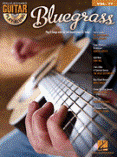 Do you want to play bluegrass songs such as
"I Am a Man of Constant Sorrow" and Merle Travis's "Nine Pound Hammer"
or instrumental tunes such as Bill Monroe's "Gold Rush" and the "Orange Blossom Special"
as quickly as possible? Listen to the CD, follow the tablature in the book and play along
to the backing track. There is rhythm, picking, ornamentation and soloing.
Staff notes and lyrics are included, and you can adjust the tempo on the CD
without changing pitch which is a nice feature.
This Play-Along is one of more than 100 volumes from AC/DC to The Who,
including Johnny Cash (see left).
Do you want to play bluegrass songs such as
"I Am a Man of Constant Sorrow" and Merle Travis's "Nine Pound Hammer"
or instrumental tunes such as Bill Monroe's "Gold Rush" and the "Orange Blossom Special"
as quickly as possible? Listen to the CD, follow the tablature in the book and play along
to the backing track. There is rhythm, picking, ornamentation and soloing.
Staff notes and lyrics are included, and you can adjust the tempo on the CD
without changing pitch which is a nice feature.
This Play-Along is one of more than 100 volumes from AC/DC to The Who,
including Johnny Cash (see left).
Hal Leonard Guitar Play-Along: Bluegrass.
Hal Leonard HL00699910,
2011, ISBN 978-1-4234-2119-1, pp61, US-$12.99 (incl. CD).
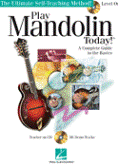 From a series of any style of mandolin playing (country, old-time, bluegrass, blues, rock)
this here is the fundamental self-teaching method. The lessons take step by step
and string by string, from the first four notes on the E string
up to using all four (double) strings.
You are now able to play stuff like "Scarborough Fair".
Afterwards it is chords, alternate picking and strumming,
the major and minor scale as well as movable chords. Full stop.
More in the other books of the series. A CD is included, a DVD is available.
From a series of any style of mandolin playing (country, old-time, bluegrass, blues, rock)
this here is the fundamental self-teaching method. The lessons take step by step
and string by string, from the first four notes on the E string
up to using all four (double) strings.
You are now able to play stuff like "Scarborough Fair".
Afterwards it is chords, alternate picking and strumming,
the major and minor scale as well as movable chords. Full stop.
More in the other books of the series. A CD is included, a DVD is available.
Douglas Baldwin, Play Mandolin Today! - A Complete Guide to the Basics.
Hal Leonard HL00699911,
2010, ISBN 978-1-4234-2142-9, pp48, US-$9.99 (incl. CD).
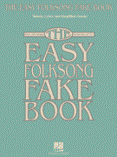 So here's over 120 folk songs in the key of C from a series of dozens of Fake Books.
It has staff notes, lyrics and simplified chords,
and it is readable without needing any eyeglasses.
From trad to contemporary folk,
from "A-Tisket A-Tasket" to the mid-19th century "The Yellow Rose of Texas";
at its core: Anglo- and African-American mainstream folk song.
From Wales comes "All Through the Night", in both English and Welsh,
from America railway songs such as "Casey Jones" and "John Henry" [#43],
and a couple of Stephen Foster songs [#45].
Scotland is featured with Robert Burns [#40],
Ireland with Thomas Moore [#37].
You can sing in German ("Du liegst mir am Herzen"),
Italian ("O Sole Mio") and even Japanese (Sakura").
A couple of instrumental tunes are thrown in for good measure,
for travelling in Arkansas as well as boating on the Volga.
Mexican composer Juventino Rosas' "Sobre las Olas" (Over the Waves)
is the connection. No background info about the songs is made available,
otherwise it is a rich source book indeed.
So here's over 120 folk songs in the key of C from a series of dozens of Fake Books.
It has staff notes, lyrics and simplified chords,
and it is readable without needing any eyeglasses.
From trad to contemporary folk,
from "A-Tisket A-Tasket" to the mid-19th century "The Yellow Rose of Texas";
at its core: Anglo- and African-American mainstream folk song.
From Wales comes "All Through the Night", in both English and Welsh,
from America railway songs such as "Casey Jones" and "John Henry" [#43],
and a couple of Stephen Foster songs [#45].
Scotland is featured with Robert Burns [#40],
Ireland with Thomas Moore [#37].
You can sing in German ("Du liegst mir am Herzen"),
Italian ("O Sole Mio") and even Japanese (Sakura").
A couple of instrumental tunes are thrown in for good measure,
for travelling in Arkansas as well as boating on the Volga.
Mexican composer Juventino Rosas' "Sobre las Olas" (Over the Waves)
is the connection. No background info about the songs is made available,
otherwise it is a rich source book indeed.
The Easy Folksong Fake Book.
Hal Leonard HL00240360,
2010, ISBN 978-1-4234-9903-9, pp150, US-$19.99.
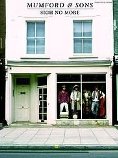 Mumford & Sons
are a London-based folk rock band, consisting of
Marcus Mumford (guitar, mandolin), Ben Lovett (keyboards, accordion), Winston Marshall
(banjo, dobro) and Ted Dwane (bass, guitar).
Their debut album "Sigh No More" (2009) peaked at #2 on the UK Album Chart,
with the singles "Little Lion Man" and "Winter Winds"
becoming chart hits as well.
The band received two Grammy nominations
and won the Brit Awards for Best Album against Take That etc.
The 12 songs of "Sigh No More" are arranged for piano, voice and guitar,
including staff notes, chords and lyrics.
They often have a strong literary influence.
The title track derives from Shakespeare's "Much Ado About Nothing",
"Roll Away Your Stone" is influenced by Macbeth.
Both "Timshel" and "Dust Bowl Dance" draw on the John Steinbeck novels "East of Eden"
and "Grapes of Wrath", respectively.
That's it. No more, no less.
Mumford & Sons
are a London-based folk rock band, consisting of
Marcus Mumford (guitar, mandolin), Ben Lovett (keyboards, accordion), Winston Marshall
(banjo, dobro) and Ted Dwane (bass, guitar).
Their debut album "Sigh No More" (2009) peaked at #2 on the UK Album Chart,
with the singles "Little Lion Man" and "Winter Winds"
becoming chart hits as well.
The band received two Grammy nominations
and won the Brit Awards for Best Album against Take That etc.
The 12 songs of "Sigh No More" are arranged for piano, voice and guitar,
including staff notes, chords and lyrics.
They often have a strong literary influence.
The title track derives from Shakespeare's "Much Ado About Nothing",
"Roll Away Your Stone" is influenced by Macbeth.
Both "Timshel" and "Dust Bowl Dance" draw on the John Steinbeck novels "East of Eden"
and "Grapes of Wrath", respectively.
That's it. No more, no less.
Mumford & Sons - Sigh No More.
Wise Publications AM1000714,
2010, ISBN 978-1-84938-570-1, pp87, €26,50.
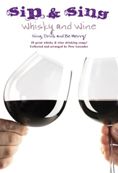 I'm praying for rain in California so the grapes can grow and they can make more wine ...
This is the counterpart to the Œuvre of
Scottish singer Robin Laing [#45]
on the other side of the Atlantic.
From a series of food and drink related song books (Coffee & Tea, Ale & Beer)
comes Sip & Sing: Whisky and Wine.
It's more or less the American songbag of the 20th century (mostly the first half),
when America unsuccessfully tried to get sober.
Best known is probably "Kisses Sweeter Than Wine".
There is also the traditional sea shanty "Whisky Johnny",
and "Drink To Me only With Thine Eyes"
became "Drink To Me Only With Gin and Tonic".
The 28 pieces on wine and whisky feature staff notes, chords and lyrics.
Salute!
I'm praying for rain in California so the grapes can grow and they can make more wine ...
This is the counterpart to the Œuvre of
Scottish singer Robin Laing [#45]
on the other side of the Atlantic.
From a series of food and drink related song books (Coffee & Tea, Ale & Beer)
comes Sip & Sing: Whisky and Wine.
It's more or less the American songbag of the 20th century (mostly the first half),
when America unsuccessfully tried to get sober.
Best known is probably "Kisses Sweeter Than Wine".
There is also the traditional sea shanty "Whisky Johnny",
and "Drink To Me only With Thine Eyes"
became "Drink To Me Only With Gin and Tonic".
The 28 pieces on wine and whisky feature staff notes, chords and lyrics.
Salute!
Sip & Sing: Whisky and Wine.
Wise Publications AM1000384,
2011, ISBN 978-1-84938-511-4, pp56, £7.95.
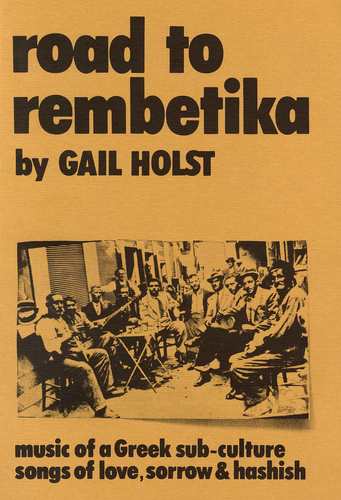
Australian-born Gail Holst first came to Greece in 1966. She already left in 1968 because of the military dictatorship, carrying with her a handful of rembetika records and a confused idea of what the rembetika were.[44]
She also had a book in Greek, namely Elias Petropoulos' song anthology (of which unfortunatly only a shortened version is available for English and German readers).[27] Petropoulos had published it by himself and had to serve a five months sentence, those were the days.
Back in Australia, Gail started looking deeper. There was a lack of reliable sources - because the music was viewed by bourgeois Greek as oriental and outmoded and despised by leftwing because of the dubious moral content of the songs and their effect on working-class -, only recordings, photographs, literary descriptions, and just a small number of interviews and autobiographies of musicians.
There are still gaps in the knowledge of its origins and early evolution, it is not even sure where the word rembetika comes from. Greek's blues music appeared towards the end of the 19th century in a number of urban centres where Greeks lived. The Turko-Greek war ended in 1922 and with its exchange of populations many refugees crowded the cities, particularly the Greek capital Athens and its port Piraeus.
The music was played by the sub-proletariat - the suffering, wronged hunted man - in the hashish dens. The water pipe passed around and a rembetis with a sorrow was throwing it out in song.


The baglama and bouzouki were its basic instruments, and the theme of songs were jail, underworld and hashish.
Come close, my dervish, and sit near me, and hear sad songs, drawn from my heart. Entertain us a while with your baglama, light up a joint and smoke with us. |
Heartless! I didn't believe that you could have no heart. You melted me like a candle, bitch, you burned me up and you don't pity me. Every time I see you I want to ask you if you'll leave me a moment's relief from sorrow, heartless wretch. But you, evil woman, want to find a poison to poison me with. Ah, evil murderess! With tricks and with your heartless ways you'll hand me over to Death. |
Gail Holst first published Road to Rembetika in 1975, a small book as an introduction to the rembetika songs. Its 4th edition has corrected the most obvious mistakes, has some changes in translations, but was not entirely re-written.
After a rather short history (which is not entirely satisfying due to the reasons mentioned above), Gail discusses rembetika modes, rhythm and verse metres. There is a bibliography (there are many publications mostly in Greek, but also some English articles in journals and single features in essay collections) and a selected discography. But best of it all is a collection of 71 songs with Greek lyrics and English translations.

Likewise as the Greek diaspora thrived musically, the Irish did. It is in the interstices between cultures that some of the most exciting things happen, an Irish arts minister once said.
In the British diaspora there were Lonnie Donegan and Kate Bush, Boy George and Dusty Springfield, The Beatles' McCartney and Lennon, the Sex Pistols' John Lydon, Oasis' Noel and Liam Gallagher, let's not forget Brighton-based Nick Burbridge,[29] and the folk and trad scene in London[44] and Manchester.[41]
Although the Irish made a major contribution to the British pop culture, their Irish context is rarely addressed and their descent not even acknowledged. Cáit O'Riordan recalls the very difficult experience of growing up London-Irish in the 1970s, having the funny name and parents who had this funny accent, with bombs going off. Many were facing anti-Irish prejudice, and Lydon's autobiography was entitled "No Irish, No Blacks, No Dogs".
Irish Blood, English Heart explores the role of Irish ethnicity in the lives and work of second-generation Irish musicians in England, presenting the case studies of Dexys Midnight Runners' Kevin Rowland (1978-86), The Pogues' Shane MacGowan (1982-91) and The Smiths' Morrissey and Johnny Marr (1982-87).
Three very different persona - one a boozing anti-hero, another a teetotaller and vegetarian. They were intermediating between Irish and English cultures, staging a dissident critique of England or - like MacGowan - forging an irreducibly London-Irish style.
For the sake of our readers I will focus on The Pogues' founder, chief songwriter and lead singer Shane MacGowan here, an expressly second-generation figure whose work supplied the first explicitly London-Irish intervention in popular music culture.
MacGowan grew up surrounded by traditional Irish music, but after transferred to London became focused on London's nascent punk scene, which included numerous London-Irish figures performing key roles.
It is little known that Jimmy Lydon's The 4Be2s already did fuse Irish music with dub. While John Lydon had played a crucial role in attracting MacGowan to punk, it was Lydon's younger sibling Jimmy who sparked MacGowan's idea for a folk-punk fusion act.
The Pogues staged a startling fusion of folk and punk, becoming an unlikely meeting point between The Clancy Brothers and The Clash and refracted strands of Irish folk music through the prism of English punk
Thus, they were critiziced as pseudo-Irish drunken morons and some sort of IRA support team. Tommy Makem called them the greatest disaster ever to hit Irish music, and they were released [by Mrs Thatcher's government] to do as much damage as they could to Irish culture.
But The Pogues were also creating a multi-ethnic diaspora space in the London capital, not only by mentioning it in songs, but also with forays into ethic sounds such as Zydeco, Spanish and Arabic music.
Part biography, part cultural history, part musical analysis Irish Blood, English Heart discusses the context of their work and even presents kind of an analysis. It is a thorough overview par example, but while interesting during the course of reading it somehow lacks a conclusion. There's even more than these three routes, approaches and means to cope with assimilated Englishness and essentialist Irishness.
Johnny Marr claimed that Irishness had a huge influence and informed his writing and playing, though harmonically and melodically he was not attracted to Irish music. But he used some folk tunings and wrote "Shakespeare's Sister" after listening intently to some Johnny Cash albums.
Graeme Thomson adds:
Country music has often been popular amongst the Irish in England with Cash being particularly popular.

In the early 1990s, Johnny Cash was a living legend, a myth, an icon, let's remember: Sun Records, Folsom Prison, San Quentin ... However, he was a bruised legend and an icon of times gone by, playing date after date with his old-fashioned family show but had no record sales and was eventually dropped by Columbia, his record company of nearly 30 years.
His career wasn't in much better shape than his body, Cash going back on pills once in a while.
It was almost as though he was being punished for not conforming to the cliché of living fast and dying young. Cash was facing the great dilemma: if he did what he'd always done he sounded old hat; if he tried to adapt he sounded forced and diluted.
But rust never sleeps, you only need a chance, and Johnny Cash got it. What happened? The short answer is the name of one man: Rick Rubin. The longer explanation lies in the 250 pages of Graeme Thomson's The Resurrection of Johnny Cash.
Rubin and Cash, an unlikely combination. Here an old-fashioned, close-text Bible-reading Christian, there a catch-all, very modern brand of Zen Gothic spirituality. But Rubin - the inscrutable, Midas-like hip hop and metal producer - was looking for an established artist to work with and was impressed by Cash.
But how to realign his genius to better fit the times? How using all those past experiences, distilling them down to their essence, and presenting Cash's music as something radical, relevant, and resonant. Rubin found it in simplicity as a virtue, just Cash and a Martin dreadnought guitar.
 With the American Recordings Johnny Cash rose like the proverbial phoenix from the ashes:
A crucial aspect was that the sparse production, free of all embellishment,
and the clever choice of material combined to make Cash appealing to a younger,
more refined audience.
The Little Black Songbook contains round about 80 of those 140 songs recorded,
just half a dozen of each of the three published "American Recordings" albums when he was still alive,
and nearly complete "Man Comes Around".
The posthumously published box "Unearthed" ist represented with 33 tracks
(among them 11 from "My Mother's Hymn Book").
Included is Cash's murder ballad "Delia's Gone" and "Give My Love to Rose",
Nick Lowe's "The Beast In Me", Neil Diamond's "Solitary Man",
U2's "One", Nick Cave's "The Mercy Seat", Nine Inch Nails' "Hurt",
as well as some of the less successful and sometimes rather painful
recordings. After all a fine volume with lyrics and chords,
you can easily put into your pocket.
Only the foreword with its clichés and half-truths
is rather unnecessary.
With the American Recordings Johnny Cash rose like the proverbial phoenix from the ashes:
A crucial aspect was that the sparse production, free of all embellishment,
and the clever choice of material combined to make Cash appealing to a younger,
more refined audience.
The Little Black Songbook contains round about 80 of those 140 songs recorded,
just half a dozen of each of the three published "American Recordings" albums when he was still alive,
and nearly complete "Man Comes Around".
The posthumously published box "Unearthed" ist represented with 33 tracks
(among them 11 from "My Mother's Hymn Book").
Included is Cash's murder ballad "Delia's Gone" and "Give My Love to Rose",
Nick Lowe's "The Beast In Me", Neil Diamond's "Solitary Man",
U2's "One", Nick Cave's "The Mercy Seat", Nine Inch Nails' "Hurt",
as well as some of the less successful and sometimes rather painful
recordings. After all a fine volume with lyrics and chords,
you can easily put into your pocket.
Only the foreword with its clichés and half-truths
is rather unnecessary.
They were looking for trigger songs that would bring the very best out of Cash and recorded 110 tracks. 13 were chosen, encompassing every major aspect of Cash's life and art: religion, death, personal struggle, America, comedy, love, sex, salvation. And thus the landmark first "American Recordings" album was released in 1994.
Cash was once again making music that was big enough to carry both him and his mythology. It was soul-searching, confrontational and anti-authoritarian. With the American Recordings, Cash once again became the country artist of choice for people who didn't like country music.
The David Letterman show introduced Cash as walking definition of cool. An artist who not only survived into old age, but virtually delivered the best of his entire career. Which artist can claim that?
Graeme Thomson is telling the story of Cash's renaissance and the subsequent recordings and releases in much detail, and along the way gives an overview about his entire career.
Last but not least, let us return to the green pastures of England, where merry peasants are singing their innocent songs and dancing the nights away ... Now, wasn't that a time. Well, not really ...
The first folk revival took place at the beginning of the 20th century, inspired and by the great collectors such as Cecil Sharp[26] and Ralph Vaughan Williams.[44] In 1898 the Folk-Song Society was founded. Sir Hubert Parry (1848-1918), director of the Royal College of Music, stated in his inaugural address:
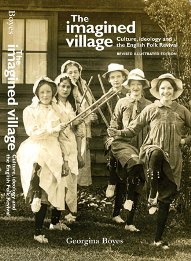
So there is an ideology behind the revival from the very beginning, which is constructing The Folk as a fiction, which existed only to sing and dance in an Imagined Village.
Collecting started, and there are many anecdotes to tell: Kate Lee was taking a job as a waitress to get hold of some folk songs which she knew were reserved for the ears of the frequenters of a country inn. Percy Grainger was tricking an elderly woman into singing songs he had earlier been refused, by hiding under her bed and recording the results of a request for them from her grand-daughter.
It is not the names of singers which are linked with English folk music at the turn of the century but those of Cecil Sharp ... The great collector was the authority. He ignored what didn't suit him, rewrote his findings and set up strict performance rules. Sharp established a virtual monopoly.
Georgina Boyes (see also Coope Boyes & Simpson)[44] continues the story of the folk revival until the 1950s and 1960s when unaccompanied informal rendering challenged conventional performance, folksong became synonymous with protest, and folk clubs sprung up all over the place. But Georgina's very detailed account is imminently Sharp's story of the folk revival and she detests (his)story. So it is Sharp bashing, to say the least.
The Imagined Village makes an interesting, not always funny but thought-provoking reading. When it was first published in 1993 it was bitterly opposed and criticized and obviously put a finger in an open wound. This is probably true still today. But it also spawned Simon Emmerson’s folk musical project The Imagined Village,[35] embracing a modern multicultural England.
What is folk music anyway?
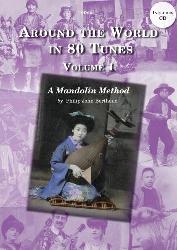
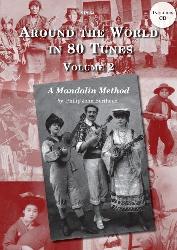 In the end it gets as fast as the Irish reel
"The Maid Behind the Bar" and sophisticated as the "Saint Louis Blues".
You're now up to the 7th fret, use your little finger and employ some dynamics.
Volume 2 starts with "Flop Eared Mule",
which the Europeans usually call "The Bluebell Polka".
It digs deeper with the Scottish jig "Hills of Glenorchy"
and the famous Venezuelan waltz "La Partida",
culminating in a couple of tunes with 7/8 time signature.
Having worked through volume 2 and its 47 tunes,
you should be able to tackle yourself your songs of choice.
Sure this method only touches on the surface of any style and tradition.
There is a CD featuring the tunes and most of the exercises,
a couple of beautiful historical pictures of lute performers,
but no background infos about the music and only a few characteristical ornamentations.
The idea is studying the mandolin while using tunes from all over the world,
it is obviously not to become an expert in any style or tradition.
You are taught to speak, but not to speak any specific idiom.
In the end it gets as fast as the Irish reel
"The Maid Behind the Bar" and sophisticated as the "Saint Louis Blues".
You're now up to the 7th fret, use your little finger and employ some dynamics.
Volume 2 starts with "Flop Eared Mule",
which the Europeans usually call "The Bluebell Polka".
It digs deeper with the Scottish jig "Hills of Glenorchy"
and the famous Venezuelan waltz "La Partida",
culminating in a couple of tunes with 7/8 time signature.
Having worked through volume 2 and its 47 tunes,
you should be able to tackle yourself your songs of choice.
Sure this method only touches on the surface of any style and tradition.
There is a CD featuring the tunes and most of the exercises,
a couple of beautiful historical pictures of lute performers,
but no background infos about the music and only a few characteristical ornamentations.
The idea is studying the mandolin while using tunes from all over the world,
it is obviously not to become an expert in any style or tradition.
You are taught to speak, but not to speak any specific idiom.
Philip John Berthoud, Around the World in 80 Tunes Volume 1 - A Folk Mandolin Method.
Spartan Press SP963,
2011, ISBN 979-0-57999-963-8, 74 S, £19.99 (incl. CD).
Philip John Berthoud, Around the World in 80 Tunes Volume 2 - A Folk Mandolin Method.
Spartan Press SP964,
2011, ISBN 979-0-57999-964-5, 55 S, £19.99 (incl. CD).
Photo Credits:
(1ff) Book Covers (from website/author/publisher);
(2) 3- & 4-Course Bouzoukis
(by Wikipedia);
(3) Shane MacGowan (unknown).